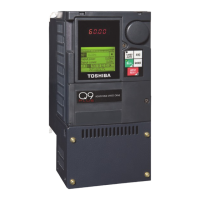Alarms, Trips, and Troubleshooting
Q9 Plus ASD Install/Op Manual
266 https://www.toshiba.com/tic/
*OL1 *ASD Overload
Load Requirement in
Excess of the Capability of
the ASD.
• Carrier frequency is too high.
• Excessive load.
• Acceleration time is too short.
• DC damping rate is too high.
• Motor is starting into a spinning load after a
momentary power failure.
• ASD is improperly matched to the application.
OLM Motor Overload Motor Overload.
• V/f setting requires adjustment.
• Motor is locked.
• Continuous operation at low speed.
• Motor is improperly matched to the load.
OLST Soft Stall Overload soft stall active.
• Soft Stall selection adjustment is required
(F017).
*OP *DC Over-Volts
DC Bus Voltage Exceeds
Specifications.
• ASD is attempting to start into a spinning motor
after a momentary power loss.
• Incoming commercial power voltage level is
above the specified range.
• Deceleration time is too short.
• Voltage spikes at the 3-phase input; install
inductive filter.
• Over-Voltage Stall feature is turned off.
• System is regenerating.
• Load fluctuations.
• Normal when Automatic Accel/Decel active.
OT Over-Torque
Torque requirement in
excess of the setting of
F616 or F617 for a time
longer than the setting of
F618.
• ASD is improperly matched to the application.
• Parameter F616 or F617 setting is too low.
• Obstructed load.
*POFF *DC Under-Volts
Under-Voltage Condition
at the 5, 15, or the 24
VDC supply.
• Defective control board.
• Excessive load on power supply.
• Low input voltage.
PTC Thermal Err
Option thermal sensor
threshold exceeded.
• User-set thermal threshold setting of F646 is
exceeded.
UC Under-Current
Output current of the ASD
is below the level defined
at F611.
• Disable detection at F610.
• Parameter F611 adjustment is required.
• Motor not connected.
Table 17. Alarms. (Continued)
LED
Screen
LCD
Screen
Alarm Description Possible Cause

